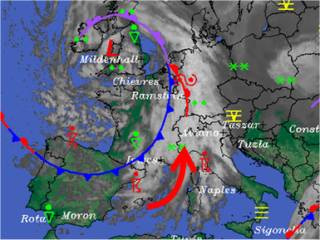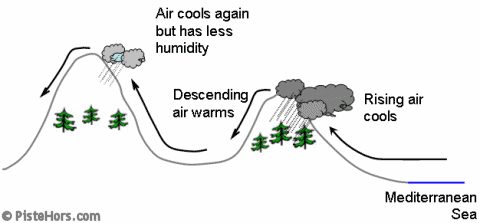
Weather > Weather and Avalanches > Wind > Foehn or Chinook
Foehn winds are traditionally associated with a low pressure area to the south-west of the Alps. The cyclonic winds head into the Alps and Pyrenees from the Mediterranean Sea. A Foehn wind is a warm, dry wind that blows down the lee (sheltered side) of mountains. Note that in the Savoie it is particuarly associated with a wind that blows over the Petit-St Bernard Pass from Italy and down the Tarentaise valley. Anyone who has skied at la Rosiere will know the strength of this wind.

The low pressure area pushes air up the windward side of the mountain. As the air rises it cools (adiabatic cooling) and clouds form when the dewpoint is reached (humidity is 100%). This may lead to snow or rain on this side of the mountain range. The rate of cooling is approximately 6.5C per 1000 meters gained. The precipitation dries the air.

As the air mass descends the other side of the mountain it is warmed by compression at around 10C per 1000 meters. Over 2000 meters this can mean that air is around 7C warmer in the valley on the lee side of the mountain range. Foehn winds can be very strong, rolling back colder air masses and causing snow to be loaded onto lee slopes forming hard snow slabs. A potential avalanche hazard. They can also lead to substantial thawing on lee slopes, hence the North American Indian name of Chinook or snow eater.
In the Alps Foehn can lead to tunnel closures as the strong winds can stop the air circulation systems from working properly.